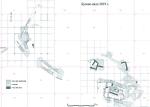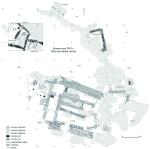Summary (English)
BUZOVO KALE FORTRESS (Deyan Rabovyanov – rabovyanov@gmail.com, Venko Ivanov) The excavations in the southeastern part of the fortress built in the 5th – 6th century AD continued. Layers were explored, containing sherds of the Early Byzantine period and the 11th – 12th centuries and five coins, one of them of Nikephoros III Botaneiates. House 4 was discovered; 80% of the sherds found there were Early Byzantine and 20% dated to the 11th – 12th centuries, while an anonymous Byzantine follis of the Class I (c. AD 1078 – 1081) was discovered as well. House 4 consisted of at least two rooms and its walls were 60 – 80 cm wide. A hearth and an oven dug below the floor were discovered close to the entrance in the eastern room. House 4 dated to the 6th century AD. House 3 was documented; its walls were 60 cm wide. A gold solidus of Justinian I was found on the floor. House 3 dated to the 6th century AD. Five postholes, four pits that accommodated ceramic vessels and a hearth were discovered beneath the floor level of House 3, belonging to two ramshackle buildings of the 5th – early 6th centuries AD. Pits 4A and 4B contained Thracian sherds of the 5th – 1st centuries BC. Layers with sherds of the Early Byzantine period and Thracian sherds of the 5th – 1st centuries BC were documented to the east of the apse of the church and behind the outer fortification wall. The inner fortification wall was c. 1.70 m wide and was constructed after the primary church (No. 1) was built. The extension of the reconstructed church (No. 2) occurred some time after the inner fortification wall was built. Debris from the burned roof and a coin hoard, the latest ones minted by Justin II and Sophia, were discovered in the northern room of the narthex of the church. A trampled level with a coin of Justinian I minted in AD 557 – 565 was documented; it was related to church No. 2 and the construction of the narthex. Four layers were documented to the west of the church, the two lower ones with traces from fires that occurred from the beginning of the 5th century AD to the AD 580s.
- Deyan Rabovyanov - Veliko Tarnovo Branch of the Archaeological Institute and Museum
- Venko Ivanov - Regional Museum of History – Pleven
Director
- Deyan Rabovyanov - Veliko Tarnovo Branch of the Archaeological Institute and Museum
- Venko Ivanov - Regional Museum of History – Pleven
Team
Research Body
- Regional Museum of History – Pleven
- Veliko Tarnovo Branch of the Archaeological Institute and Museum






![Download [PDF]](/excavation/skins/fasti/images/results/download_sml.png)

